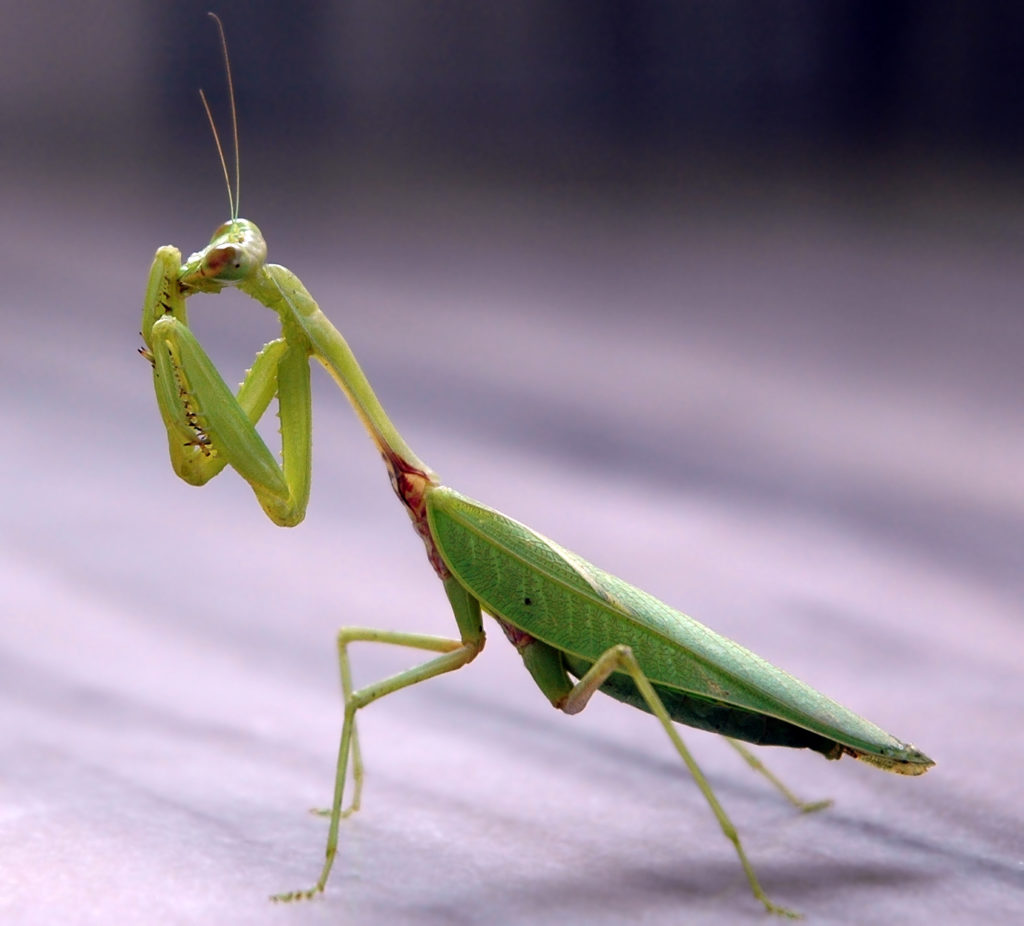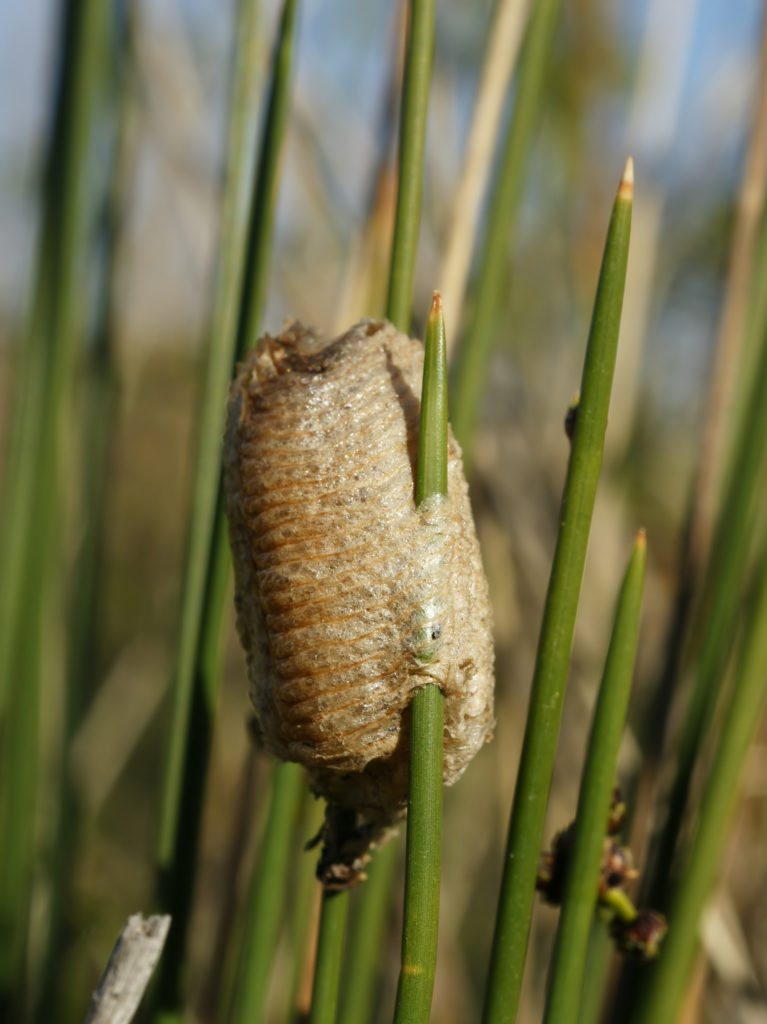Almanac: Perilous Procreation

Female praying mantis (Mantis religiosa). Photo: Creative Commons
On an unusually balmy evening recently I was eating dinner with a friend on her porch when I noticed a large insect clinging to a nearby window. I walked over to investigate. It was a beautiful, lime green female praying mantis, and it was watching me. As I neared, it turned its large, triangular head and edged slowly away, still clinging to the glass.
Mantids have excellent eyesight. Their bulging compound eyes give them binocular vision, and their necks are so flexible they can turn their heads to precisely track prey—or curious humans. Mantid necks, in fact, are among the most flexible of all insects—they can “look over their shoulders,” which is unique to mantids. They also have exquisite hearing tuned to ultrasonic frequencies. This allows them to detect the high-pitched pulses used by bats for echolocation. Hearing such pulses, a flying mantid will suddenly zig-zag erratically to elude its foe.
Mantids are distinguished by their conspicuously large “raptorial” front legs. They extend these legs with lightning speed, snaring prey and holding it tight. The legs are usually held in a folded position that suggested devotion to early naturalists. (The word “mantis” is taken from the Greek word for “prophet.”) The lady I was observing on the window was a European Mantis, so named because this species of mantis was introduced by accident on imported nursery stock in 1899. The scientific name is a nod to the common name: Mantis religiosa.
Naturalists have observed males successfully impregnating females despite the fact that the female had already begun devouring them.
Mantids are not exactly peace-loving, pious types, however. Not only are the insects ruthlessly predatory, eating practically anything they can get their extendible little legs on, but their mating habits are barbaric by human standards. Female mantids would as soon eat a male as mate with one. Since males are smaller than the females this makes mating a very dicey affair. An amorous male must stalk his love very carefully, and leap on her back just so. If the male misjudges the trajectory or is a wee bit off course, his goose is cooked. If the female is hungry she’ll rip him apart, starting with the head.
But if he lands just right he can usually avoid her grasp while he hangs on for dear life and copulates as quickly as possible. Even when all seems to be going well, however, things can go south for a male. Roughly one-in-four male/female encounters end with the female using her oh-so-flexible neck to grab him and start eating the hapless suitor mid-insemination.
Such sexual cannibalism isn’t unknown in the insect world and we probably shouldn’t shed too many tears for the poor males. Mantids have extremely decentralized nervous systems. Their “brain” is nothing more than a spinal cord with lumps of neurons, called ganglia, spread along its length. This is advantageous because it enables parts of the body to work even if other parts are severely injured or missing. Naturalists have observed males successfully impregnating females despite the fact that the female had already begun devouring them. In fact, the bodies of decapitated males who have already mounted a female may become even more vigorous in their delivery of sperm into the female’s genitalia. The nourishment the female gets from eating her mate may help ensure high egg production thus contributing to the preservation of the species.
Since adult praying mantises can’t survive our harsh winters, the species survives by passing the winter in egg form. This is the time of year mantids are mating and the females are laying eggs. Between 10 and 400 tiny eggs are deposited on a weed or tree stem. The female then covers the eggs with a sticky froth that quickly hardens to a tough insulating pod that has the consistency of Styrofoam. You may see these on walks in fields—the tan egg cases are the size of large almonds and have distinctive ridges.

Next spring tiny, pale, gangling mantises will emerge from their protective home and immediately start feeding. Praying mantises experience the simplest form of insect development: simple metamorphosis. This means that the insects’ form does not change significantly from the time they first emerge from the egg to the adult phase. They simply grow progressively larger, shedding their skins many times in the process.
Young mantids of both sexes are as rapacious as adults. If food is scarce when they emerge from the egg case, they’ll happily start eating each other. This willy-nilly, matter-of-fact cannibalism is survival-of-the-fittest at its most naked and brutal, and it feels foreign to us highly social humans. We may slaughter each other with impunity, but we don’t usually eat each other. Perhaps on some other planet a species of emotionless, violent, cannibalistic creatures have evolved intelligence and advanced technology. I would like to think that natural selection would somehow prevent that possibility, but who knows? I’m just glad I don’t have to worry about bumping into a human-sized, intelligent mantid on my walks in the woods!
Almanac is a regular Indy column of observations, musings, and occasional harangues related to the woods, waters, mountains, and skies of the Pioneer Valley. Please feel free to comment on posts and add your own experiences or observations.

This is a masterpiece. All of Steve’s Almanac essays are marvelous, but this one especially is a model of superb writing, clear explanation, perfect construction and elegance. What a gift he offers to readers!